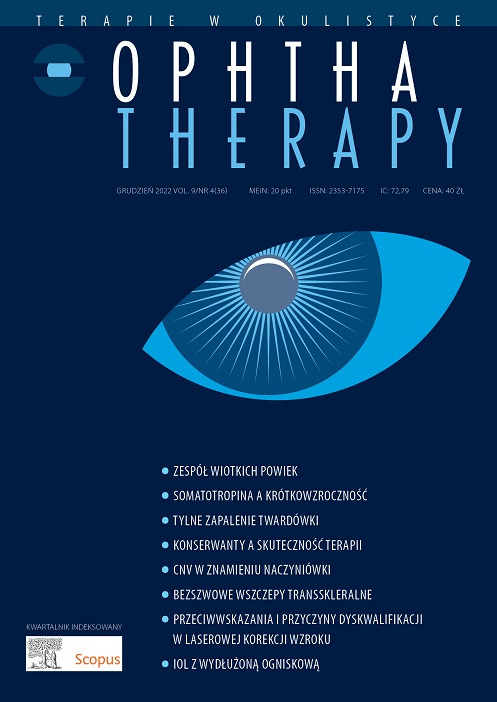Operacja wtórnego wszczepienia soczewki transskleralnej metodą bezszwową – obserwacje własne Artykuł oryginalny
##plugins.themes.bootstrap3.article.main##
Abstrakt
Cel pracy: Przedstawienie wyników operacji wszczepiania soczewki wewnątrzgałkowej typu Carlevale™ o fiksacji transskleralnej metodą bezszwową na podstawie własnych doświadczeń.
Materiał i metody: Operacji wszczepienia metodą bezszwową soczewki transskleralnej typu Carlevale™ poddano 39 osób (40 oczu) z afakią po operacji usunięcia podwichniętej soczewki własnej lub sztucznej, w tym 10 pourazowych i jednego pacjenta z podwichniętą sztuczną soczewką o fiksacji transskleralnej z użyciem szwów niewchłanialnych. Pacjenci pozostawali pod obserwacją w okresie od 6 do 18 miesięcy.
Wyniki: U 80% pacjentów po operacji uzyskano ostrość wzroku taką jak przed zabiegiem lub lepszą (20% osiągnęło 1,0 w skali dziesiętnej bez korekcji). U nieco ponad połowy obserwowano powikłania śródoperacyjne i pooperacyjne. Do najczęstszych należały: keratopatia, niewielkie krwawienie do komory ciała szklistego, rozejście się rany spojówki oraz zaburzenia ciśnienia wewnątrzgałkowego. W większości nie pozostawiły one trwałych następstw.
Wnioski: Wszczepienie sztucznej soczewki o fiksacji transskleralnej bez użycia szwów wydaje się efektywną i stosunkowo bezpieczną metodą leczenia afakii. Jednakże ocena trwałości fiksacji bezszwowej wymaga dalszych badań.
Pobrania
##plugins.themes.bootstrap3.article.details##

Utwór dostępny jest na licencji Creative Commons Uznanie autorstwa – Użycie niekomercyjne – Bez utworów zależnych 4.0 Międzynarodowe.
Copyright: © Medical Education sp. z o.o. License allowing third parties to copy and redistribute the material in any medium or format and to remix, transform, and build upon the material, provided the original work is properly cited and states its license.
Address reprint requests to: Medical Education, Marcin Kuźma (marcin.kuzma@mededu.pl)
Bibliografia
2. Dick HB, Augustin AJ. Lens implant selection with absence of capsular support. Curr Opin Ophthalmol. 2001; 12(1): 47-57. http://doi.org/10.1097/00055735-200102000-00009.
3. Tang Y, Xu J, Chen J et al. Long-Term Destiny of Corneal Endothelial Cells in Anterior Chamber Intraocular Lens Implanted Eyes. J Ophthalmol. 2020; 2020: 5967509. http://doi.org/10.1155/2020/5967509.
4. Soleko IOLDivision. Charakterystyka produktu, karta katalogowa FIL SSF Carlevale Lens.
5. Vaiano AS, Hoffer KJ, Greco A et al. Long-term Outcomes and Complications of the New Carlevale Sutureless Scleral Fixation Posterior Chamber IOL. J Refract Surg. 2021; 37(2): 126-32. http://doi.org/10.3928/1081597X-20201207-02.
6. Fiore T, Messina M, Muzi A et al. A novel approach for scleral fixation using Carlevale lens. Eur J Ophthalmol. 2021; 31(6): 2947-54. http://doi.org/10.1177/1120672121991358.
7. Georgalas I, Spyropoulos D, Gotzaridis S et al. Scleral fixation of Carlevale intraocular lens: A new tool in correcting aphakia with no capsular support. Eur J Ophthalmol. 2022; 32(1): 527-33. http://doi.org/10.1177/1120672121992978.
8. Rouhette H, Meyer F, Pommier S et al. FIL-SSF Carlevale intraocular lens for sutureless scleral fixation: 7 recommendations from a serie of 72 cases. MICA study (Multicentric Study of the Carlevale IOL). J Fr Ophtalmol. 2021; 44(7): 1038-46. http://doi.org/10.1016/j.jfo.2021.05.002.
9.Mularoni A, Imburgia A, Forlini M et al. In vivo evaluation of a 1-piece foldable sutureless intrascleral fixation intraocular lens using ultrasound biomicroscopy and anterior segment OCT. J Cataract Refract Surg. 2021; 47(3): 316-22. http://doi.org/10.1097/j.jcrs.0000000000000444.
10. Sindal MD, Nakhwa CP, Sengupta S. Comparison of sutured versus sutureless scleral-fixated intraocular lenses. J Cataract Refract Surg. 2016; 42(1): 27-34. http://doi.org/10.1016/j.jcrs.2015.09.019.

